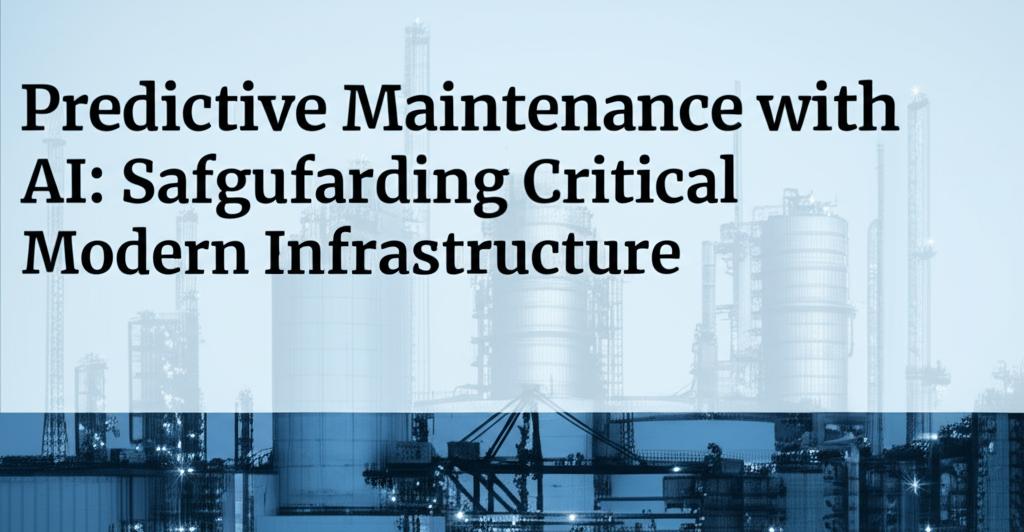In an era where our daily lives and economies depend heavily on the seamless operation of critical infrastructure – from power grids and water systems to transportation networks and communication lines – the stakes have never been higher. These complex, often aging systems face mounting pressures from increased demand, environmental stressors, and security threats. Enter Artificial Intelligence (AI), a transformative technology poised to revolutionize how we safeguard these vital assets through the power of predictive maintenance.
Traditionally, maintenance of critical infrastructure has been reactive (fixing things after they break) or preventive (scheduled maintenance based on time or usage, regardless of actual condition). While preventive measures are an improvement, they can lead to unnecessary work and still don't entirely eliminate the risk of unexpected failures. AI-driven predictive maintenance, however, represents a paradigm shift. By harnessing the power of machine learning algorithms, IoT sensors, and big data analytics, this approach allows us to forecast potential equipment failures with remarkable accuracy before they occur.
How AI is Making a DifferenceImagine a vast network of sensors deployed across a city's power grid, constantly collecting real-time data on everything from voltage fluctuations and transformer temperatures to the vibrations in transmission lines. AI algorithms sift through this colossal stream of information, identifying subtle anomalies and patterns that would be invisible to human operators. These patterns can be early warning signs of impending issues, such as a component nearing the end of its lifecycle or an emerging fault.
This foresight allows infrastructure operators to move from a "just-in-case" to a "just-in-time" maintenance strategy. Instead of replacing parts on a fixed schedule, maintenance teams can intervene precisely when and where needed, optimizing resource allocation and minimizing disruptions.
The Multifaceted BenefitsThe advantages of AI-powered predictive maintenance are far-reaching:
- Reduced Downtime and Costs: Unplanned downtime in critical infrastructure can have catastrophic consequences, leading to service disruptions, economic losses, and even public safety risks. By predicting failures, AI significantly reduces these costly interruptions and the expenses associated with emergency repairs. Maintenance becomes more targeted and efficient, extending the lifespan of assets and preserving resources.
- Enhanced Safety and Resilience: Proactively addressing potential vulnerabilities strengthens the safety and resilience of our infrastructure. AI can help detect wear and tear that could lead to widespread outages in power grids or identify abnormalities in water supply systems that might compromise public health. This proactive stance is crucial in protecting against both natural disasters and malicious attacks.
- Optimized Resource Management: AI enables smarter management of essential resources like energy and water. For instance, in energy grids, AI algorithms can more accurately forecast demand and adjust supply in real-time, reducing waste and operational costs.
- Improved Reliability: For sectors like transportation and telecommunications, reliability is paramount. AI-driven predictive maintenance in railways, for example, analyzes data from tracks and trains to predict issues, enhancing safety and minimizing delays. Similarly, telecom companies are using AI to anticipate hardware and software failures, ensuring network uptime.
The application of AI in predictive maintenance isn't just theoretical; it's already delivering tangible results across various sectors. Energy companies are using AI to predict faults in wind turbines and solar panels, reducing maintenance costs and increasing operational efficiency. In public transportation, systems like the New York City Subway leverage AI and IoT sensors to predict equipment failures, optimize maintenance schedules, and improve service reliability for millions of commuters. Verizon, a major telecommunications provider, has seen a significant reduction in network failures and emergency repair costs by implementing AI-powered predictive maintenance.
The Road Ahead: Challenges and Future TrendsDespite the immense potential, the journey towards widespread adoption of AI in predictive maintenance isn't without its challenges. Data quality and availability are crucial, as inaccurate or insufficient data can undermine the accuracy of predictions. The complexity of AI models can also make it difficult for operators to interpret results, sometimes leading to resistance in adoption. Furthermore, ensuring the security and privacy of the vast amounts of data collected is a critical concern.
Looking ahead, the field is rapidly evolving. We can expect even more sophisticated AI and machine learning algorithms capable of predicting complex failure modes. The integration of AI with other emerging technologies like edge computing (processing data closer to its source for faster insights), digital twins (virtual replicas of physical assets), and augmented reality (AR) for remote maintenance support will further enhance capabilities. As AI technology continues to mature, its role in safeguarding our critical modern infrastructure will only become more indispensable, paving the way for a more resilient, efficient, and secure future. The global market for AI-based predictive maintenance is already experiencing significant growth and is projected to expand further, underscoring the increasing reliance on these intelligent solutions.

